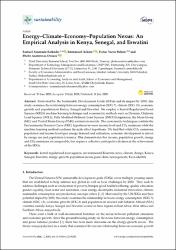Energy-Climate-Economy-Population Nexus: An Empirical Analysis in Kenya, Senegal, and Eswatini
Özet
Motivated by the Sustainable Development Goals (SDGs) and its impact by 2030, this study examines the relationship between energy consumption (SDG 7), climate (SDG 13), economic growth and population in Kenya, Senegal and Eswatini. We employ a Kernel Regularized Least Squares (KRLS) machine learning technique and econometric methods such as Dynamic Ordinary Least Squares (DOLS), Fully Modified Ordinary Least Squares (FMOLS) regression, the Mean-Group (MG) and Pooled Mean-Group (PMG) estimation models. The econometric techniques confirm the Environmental Kuznets Curve (EKC) hypothesis between income level and CO(2)emissions while the machine learning method confirms the scale effect hypothesis. We find that while CO(2)emissions, population and income level spur energy demand and utilization, economic development is driven by energy use and population dynamics. This demonstrates that income, population growth, energy and CO(2)emissions are inseparable, but require a collective participative decision in the achievement of the SDGs.
Cilt
12Sayı
15Bağlantı
https://hdl.handle.net/11363/2414Koleksiyonlar
Aşağıdaki lisans dosyası bu öğe ile ilişkilidir:


















